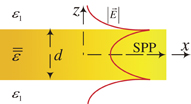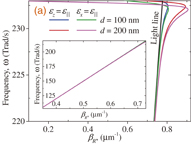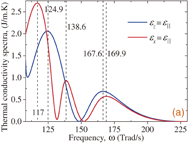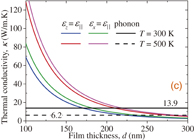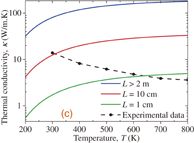Abstract
The effects of the permittivity anisotropy and size of a nano thin film on its thermal conductivity due to surface phonon-polaritons are studied. We demonstrate that this thermal conductivity is a linear combination of the inverse first and third powers of the film thickness. For a 100-nm-thick film of α-quartz surrounded by air, the thermal conductivity along the optical axis is comparable to the phonon counterpart and equals 13 W m−1 K−1, which is 25% higher than that along the perpendicular direction, at room temperature. Higher values are found for thinner films at higher temperatures.
Export citation and abstract BibTeX RIS
Surface phonon-polaritons (SPPs) are electromagnetic waves generated by coupling between photons and phonons at the interface between two media.1–3) Over the past few years, various research groups have shown that these surface waves have promising applications for improving the thermal performance of nanoscale devices,4–6) radiative heat transfer,7–10) high-density infrared data storage,11) surface infrared absorption,12) coherent thermal emission,13) and photonics.14,15) In these cases, the operating principles are based on the fact that in nanomaterials, the surface effects predominate over the volumetric ones, so the energy transport by SPPs is particularly important. The SPP energy contribution increases as the material size is scaled down in the direction perpendicular to the propagation one.4,6)
SPPs can have long propagation lengths, on the order of a few centimeters on thin films,4–6) which in turn could lead to efficient energy transport. Using the Boltzmann transport equation, Chen et al.4) showed that the SPP thermal conductivity of a 40-nm-thick thin film of silicon dioxide suspended in air is 4 W m−1 K−1 at 500 K. This result has been confirmed by the fluctuation–dissipation theorem16) and is consistent with experimental data for the propagation length.5) More recently and using a fully analytical approach, we showed that a substrate with a permittivity slightly different than that of the superstrate of a nano thin film can generate large propagation lengths and therefore significantly enhance its SPP thermal conductivity. Because the absorption of energy by the film and its surrounding media is determined by their permittivities, thin films with anisotropic permittivity are expected to provide more variables than isotropic ones for controlling and optimizing the SPP energy transport.
The purpose of this letter is to analyze the effects of the anisotropic permittivity and size of biaxial crystalline thin films on their SPP thermal conductivity. For nano thin films, an explicit expression for the SPP thermal conductivity as a function of their thickness is obtained, which provides clear physical insights into how the heat transport depends on the permittivity of the thin film and its surrounding media.
Let us consider a layered system supporting the propagation of SPPs, as shown in Fig. 1. The SPPs are generated within the thin film by the fluctuation of microscopic electrical dipoles, which oscillate under thermal excitation and emit an electric field E. This field induces the excitation of neighboring surface electrical dipoles, which maintain the propagation of the field (SPP) along the film (Fig. 1).1,4,6) These electrical dipoles are spontaneously present in polar materials, such as SiO2, SiC, and α-quartz. This is why these materials can support the propagation of SPPs. The thin film here is a biaxial crystal described by its permittivity tensor,

where εj for j = x, y, z are the frequency-dependent permittivities along the principal axes of the anisotropic crystal. The surrounding medium on either side has a constant permittivity ε1 > 0, as does air, within a wide frequency range.17)
Fig. 1. Cross section of thin film under consideration.
Download figure:
Standard image High-resolution imageBy solving the Maxwell equations under the proper boundary conditions for the transverse magnetic polarization required for the existence of surface polaritons,4) the following dispersion relation for the wave vector β along the x-axis is obtained:

where the transverse wave vectors inside and outside of the film are given by  and
and  , respectively; k0 = ω/c, where ω is the excitation frequency, and c is the speed of light in vacuum. Note that the dispersion relation in Eq. (2) depends on the permittivity along (εx) and across (εz) the direction of SPP propagation, but not on the permittivity along the y-axis, because the SPPs do not propagate in this direction. Equation (2) can be significantly simplified for a thin film (|p2|d ≪ 2), which is of interest in this work to examine the enhanced SPP propagation along the film. For a nano thin film of α-quartz, this condition is satisfied well for d ≤ 300 nm. In this case, the left-hand side of Eq. (2) can be approximated well by a first-order approximation of d, such that tanh(p2d/2) ≈ p2d/2. Therefore, Eq. (2) reduces to
, respectively; k0 = ω/c, where ω is the excitation frequency, and c is the speed of light in vacuum. Note that the dispersion relation in Eq. (2) depends on the permittivity along (εx) and across (εz) the direction of SPP propagation, but not on the permittivity along the y-axis, because the SPPs do not propagate in this direction. Equation (2) can be significantly simplified for a thin film (|p2|d ≪ 2), which is of interest in this work to examine the enhanced SPP propagation along the film. For a nano thin film of α-quartz, this condition is satisfied well for d ≤ 300 nm. In this case, the left-hand side of Eq. (2) can be approximated well by a first-order approximation of d, such that tanh(p2d/2) ≈ p2d/2. Therefore, Eq. (2) reduces to

which, given the definition of p2, depends only on the permittivity εz along the axis perpendicular to the film plane. As the film thickness is scaled down, the coupling of the electric and magnetic fields traveling along the two interfaces of the film becomes stronger; therefore, the dispersion relations of these fields should become more sensitive to εz than to εx. This shows that the separation of the permittivities in the dispersion relation of nano thin films is reasonable. Equation (3) is equal to our previous result for isotropic media after the substitution εz → ε2.6) Hence, using the analytical expressions for the real part βR of β = βR + iβI and the propagation length Λ = 1/(2βI) derived for this case,6) the SPP thermal conductivity can be written as

where


with εz = εR + iεI and ξ = |εz|2 − ε1εR, which must be positive for any ω > 0, to guarantee the propagation of SPPs (Λ > 0). Within the thin film limit (|p2|d ≪ 2), the simple Eq. (4) establishes that the increase in the SPP thermal conductivity as the film thickness decreases is determined entirely by the material-dependent parameters A and B. When  , κ is driven by the inverse of the film thickness, whereas for
, κ is driven by the inverse of the film thickness, whereas for  , κ is inversely proportional to the cube of this thickness. The smaller values of the film thickness d are set by the surface roughness height and peak-to-peak distance, which are typically on the order of 1 nm.4)
, κ is inversely proportional to the cube of this thickness. The smaller values of the film thickness d are set by the surface roughness height and peak-to-peak distance, which are typically on the order of 1 nm.4)
The quantification of the SPP thermal conductivity and its dependence on the anisotropic permittivity and size are now analyzed for a thin film of α-quartz surrounded by air (ε1 = 1). This material is a polymorph of SiO2 (silica), which is abundant in nature and widely used in electronic applications.1,18) Further, α-quartz is commonly employed in the manufacturing of electrical circuits, in which thermal sources generated by the Joule effect might be cooled via SPPs. Furthermore, this material is also of fundamental importance in mineralogy and crystallography regarding the quantification of its thermal properties.19) The permittivities in the directions parallel (j = ||) and perpendicular (j = ⊥) to its optical axis are given by18)

where Ωjn and ωjn are the longitudinal and transverse optical frequencies, respectively; γjn is a damping constant, and  is the high-frequency permittivity. The experimental values of these parameters for the N|| = 4 (N⊥ = 8) vibrational branches parallel (perpendicular) to the optical axis of α-quartz are reported in the literature.18) Using Eq. (6), it can be shown that the maxima of the imaginary part of εj occur at ω = ωjn for ωjn ≫ γjn, as is the case for α-quartz and most crystals. This indicates that these materials absorb significant energy from the electromagnetic field at those frequencies.
is the high-frequency permittivity. The experimental values of these parameters for the N|| = 4 (N⊥ = 8) vibrational branches parallel (perpendicular) to the optical axis of α-quartz are reported in the literature.18) Using Eq. (6), it can be shown that the maxima of the imaginary part of εj occur at ω = ωjn for ωjn ≫ γjn, as is the case for α-quartz and most crystals. This indicates that these materials absorb significant energy from the electromagnetic field at those frequencies.
Figures 2(a) and 2(b) show the frequency dependence of the real and imaginary parts of the permittivity parallel (ε||) and perpendicular (ε⊥) to the optical axis of α-quartz, respectively. The sharp resonance peaks of the imaginary parts of both ε|| and ε⊥, along with their small values for broad frequency ranges, show that the SPPs can propagate over relatively large distances within these frequency intervals. ε|| has fewer absorption peaks than ε⊥; hence, the SPP energy transport is expected to be more efficient along the optical axis (εx = ε||) than along the perpendicular axis (εx = ε⊥).
Download figure:
Standard image High-resolution imageFig. 2. Real (εR) and imaginary (εI) parts of the permittivity (a) parallel and (b) perpendicular to the optical axis of α-quartz as a function of frequency.
Download figure:
Standard image High-resolution imageThe dispersion relation and propagation length of SPPs traveling along the film/air interface are shown in Figs. 3(a) and 3(b), respectively. The displayed range of frequencies is determined by the conditions for the existence [Re(pl) > 0, for l = 1, 2] and propagation (Λ > 0) of SPPs. For SPPs traveling along the optical axis of α-quartz (εx = ε|| and εy = εz = ε⊥), this range is 101 < ω < 233 Trad/s, whereas for SPPs propagating along the axis of ε⊥ (εx = ε⊥ and εy = εz = ε||), the frequency interval is 108 < ω < 233 Trad/s. Note that for both propagation directions, βR decreases and approaches the light line as the frequency decreases. This indicates that the SPPs are photon-like in nature. As the frequency increases, the dispersion relation separates from the light line and tends to phonon-like behavior. This feature strengthens when the film thickness increases. The corresponding propagation lengths in Fig. 3(b) take larger values at the frequencies where the absorption of energy is minimal (Fig. 2). For each propagation direction, the maxima of Λ are independent of d and depend on both the real and imaginary parts of the respective permittivity, as was shown previously.6)
Download figure:
Standard image High-resolution imageFig. 3. (a) Dispersion relation and (b) propagation length as a function of the frequency for a thin film of α-quartz surrounded by air.
Download figure:
Standard image High-resolution imageThe real parts of the transverse wave vectors inside and outside of the thin film are positive, as shown in Fig. 4(a). This fact, along with Fig. 3(b), reveals that the SPPs propagate in a broad frequency band. This is further confirmed by the distribution of the Poynting vector shown in Fig. 4(b). The energy flux propagating inside the film is close to zero and negligible compared with that outside of it, owing to the very small absorption by the surrounding air. The high concentration of energy at the interface enables the absorbing film to support the propagation of SPPs. As a result of the coupling of the electromagnetic fields traveling along both film interfaces, the energy flux increases as the film thickness decreases. This indicates that the SPP thermal conductivity should increase as the film thickness is reduced, which is consistent with Eq. (4) and Fig. 3(b).
Download figure:
Standard image High-resolution imageFig. 4. (a) Frequency dependence of Re(pj) inside and outside of a 100-nm-thick film of α-quartz surrounded by air. (b) Poynting vector distribution at x = 0 and ω = 169.9 Trad/s for SPPs propagating along the optical axis.
Download figure:
Standard image High-resolution imageThe integrand of the SPP thermal conductivity κ, which is defined in Eq. (4) as a function of the frequency, is shown in Fig. 5(a) for SPP propagation along the two principal axes of the α-quartz film. Note that the oscillatory behavior of these spectra is determined by the permittivity, and their maxima coincide with the corresponding ones of the propagation lengths shown in Fig. 3(b). The major contributions to κ (area under the curve) arise from the vicinity of these peaks, as shown by the cumulative thermal conductivity in Fig. 5(b). The increase in κ exhibits an inflection point at the frequency where the maxima of Λ occur. κ increases as the film thickness decreases, and it can be much larger than its phonon counterpart for a film thickness of less than 170 nm, as shown in Fig. 5(c). It is clear that κ becomes significant for nano thin films and is negligible for micro thin films, as suggested previously.4,6) κ is higher when the SPPs propagate along the principal axis (the optical axis, in this case) with smaller absorption, as expected. The enhancement of κ due to the permittivity anisotropy of α-quartz increases for smaller film thicknesses and lower temperatures. For d = 100 nm, it passes from 25% at T = 300 K to 14% at T = 500 K. Thus, it is clear that κ is fairly sensitive to the propagation direction and temperature of the anisotropic film. In contrast to the phonon thermal conductivity of α-quartz, the SPP one increases with temperature [Fig. 5(d)]. This shows that SPPs have the potential to diminish the overheating of materials under high operating temperatures by increasing their thermal conductivity.
Download figure:
Standard image High-resolution imageDownload figure:
Standard image High-resolution imageDownload figure:
Standard image High-resolution imageFig. 5. (a) Thermal conductivity spectrum and (b) its cumulative values for d = 100 nm and T = 300 K. Thermal conductivity as a function of (c) film thickness and (d) temperature (d = 100 nm). Experimental points represent the phonon counterpart of α-quartz along its optical axis.
Download figure:
Standard image High-resolution imageThe source of the high SPP thermal conductivity is the propagation length at small wavevectors, which are very close to the light line, as shown in Figs. 3(a) and 3(b). The largest propagation length in this photon-like regime is about 1 m for a 100-nm-thick film of α-quartz. This large value of Λ implies that only thin films with a length (L) longer than this distance (L ≫ Λ) can benefit from the enhanced SPP thermal conductivity. In practice, however, L is not very long; therefore, the propagation length has to be redefined. For this case, Matthiessen's rule establishes that the effective propagation length (Λe) is given by  . Thus, the effect of the film length L on the SPP energy transport appears through the reduction of the intrinsic propagation length Λ. To quantify the associated SPP thermal conductivity, we use the explicit expression for κ in terms of the propagation length.4,6)
. Thus, the effect of the film length L on the SPP energy transport appears through the reduction of the intrinsic propagation length Λ. To quantify the associated SPP thermal conductivity, we use the explicit expression for κ in terms of the propagation length.4,6)
Figure 6(a) shows the effective propagation length of SPPs propagating along the optical axis of the thin film for three lengths L. The case of L > 2 m corresponds to Λe = Λ. Note that Λe follows the same trend as Λ, and its maximum values are smaller but comparable to those of L. This reduction in the propagation length from meters to centimeters has a strong impact on the SPP thermal conductivity κ, as shown in Fig. 6(b). For T = 300 K and d = 100 nm, κ decreases from 82 to 13 W m−1 K−1 when the film length is scaled down from L > 2 m to L = 10 cm. Despite this sizable reduction in κ, Fig. 6(b) shows that the SPP thermal conductivity (13 W m−1 K−1) for a 10-cm-long film is only 1.1 W m−1 K−1 smaller than its phonon counterpart (14.1 W m−1 K−1). This indicates that the SPPs can still significantly enhance the phonon thermal conductivity of nano thin films. Although lower values of κ are obtained for a smaller film length (L = 1 cm), this reduction can be offset at higher temperature, as shown in Fig. 6(c).
Download figure:
Standard image High-resolution imageDownload figure:
Standard image High-resolution imageFig. 6. (a) Frequency dependence of propagation length for εx = ε∥ and thermal conductivity as a function of (b) film thickness and (c) temperature for three film lengths. Film thickness in (a) and (c) is d = 100 nm.
Download figure:
Standard image High-resolution imageIn summary, the energy transport of SPPs along nano thin films can be optimized by choosing the propagation direction along the axis of less absorption, decreasing the film thickness, increasing the film length, and raising the temperature. A simple expression for the SPP thermal conductivity as a linear combination of the inverse first and third powers of the film thickness was derived. A thermal conductivity of 13 W m−1 K−1 was obtained for a thin film 100 nm in thickness and 10 cm in length at room temperature.


